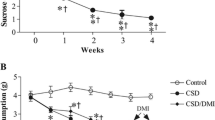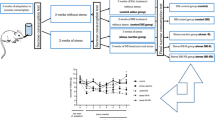Abstract
Chronic sequential exposure to a variety of mild stressors has previously been found to cause an antidepressant-reversible decrease in the consumption of palatable sweet solutions, associated with abnormalities of dopaminergic neurotransmission in the nucleus accumbens. In the present study, 5 weeks of treatment with imipramine (10 mg/kg b.i.d.) reversed the decreased sucrose intake of rats exposed to chronic mild stress. Stress also caused a decrease in D2-receptor binding in the limbic forebrain (but not the striatum), which was completely reversed by imipramine. In nonstressed animals, imipramine decreased D1-receptor binding in both regions. However, in stressed animals, imipramine did not significantly alter D1-receptor binding in either area. Stress alone slightly increased D1-receptor binding, in striatum only. Scatchard analysis showed that all changes in receptor binding resulted from changes in receptor number (Bmax) rather than receptor affinity (KD). The results support the hypothesis that changes in D2-receptor function in the nucleus accumbens are responsible for chronic mild stress-induced anhedonia and its reversal by antidepressant drugs. They do not support the hypothesis that the sensitization of D2-receptors seen following chronic antidepressant treatment is caused by a down-regulation of D1-receptors.
Similar content being viewed by others
References
American Psychiatric Association (1987) DSM III R — Diagnostic and Statistical Manual of Psychiatric Disorders, 3rd edn, revised. APA, Washington DC
Arnt J, Hytell J, Overo KF (1984) Prolonged treatment with the specific 5-HT uptake inhibitor citalopram: Effect on dopaminergic and serotonergic functions. Pol J Pharm Pharm 36: 221–230
Besson M-J, Graybiel AM, Nartuk MA (1988) [3H]SCH23390 binding to D1 dopamine receptors in the basal ganglia of the cat and primate: delineation of strisomal compartments and pallidal and nigral subdivisions. Neuroscience 26: 101–119
Burger LY, Martin-Iverson MT (1993) Day/night differences in D1 but not D2 DA receptor protection from EEDQ denaturation in rats treated with continuous cocaine. Synapse 13:20–29
Cheeta S, Broekkamp CLE, Willner P (1994) Stereo specific reversal of stress-induced anhedonia by mianserin and its (+)-enantiomer. Psychopharmacology (in press)
Klimek V, Maj J (1989) Repeated administration of antidepressant drugs enhanced agonist affinity for mesolimbic D-2 receptors. J Pharm Pharmacol 41: 555–558
Klimek V, Nielsen M (1987) Chronic treatment with antidepressants decreases the number of [3H]SCH 23390 binding sites in the rat striatum and limbic system. Eur J Pharmacol 139: 163–169
Loopjit LD, Sebens JB, Korf J (1987) A mosaic-like distribution of dopamine receptors in rat neeostriatum and its relationship to striosomes. Brain Res 405: 405–408
Maj J (1988) Repeated treatment with antidepressant drugs and functional changes of catecholajminergic receptors at the behavioural level. In: Belmaker RH, Sandler M, Dahlstrom A (eds) Progress in Catecholamine Research: part C, Clinical Aspects. Liss, New York, pp 255–261
Maj J, Wedzony K (1985) Repeated treatment with imipramine or amitriptyline increases the locomotor response of rats to (+)-amphetamine given into the nucleus accumbens. J Pharm Pharmacol 37: 362–364
Maj J, Wedzony K (1988) The influence of oxaprotaline enantiomers given repeatedly on the behavioural effects ofd-amphetamine and dopamine injected into the nucleus accumbens. Eur J Pharmacol 145: 97–103
Maj J, Rogoz Z, Skuza G, Sowinska H (1984a) Repeated treatment with antidepressant drugs potentiates the locomotor response to (+)-amphetamine. J Pharm Pharmacol 36: 127–130
Maj J, Rogoz Z, Skuza G, Sowinska H (1984b) Repeated treatment with antidepressant drugs increases the behavioural response to apomorphine. J Neural Transm 60: 273–282
Maj J, Wedzony K, Klimek V (1987) Desipramine given repeatedly enhances behavioural effects of dopamine andd-amphetamine injected into the nucleus accumbens. Eur J Pharmacol 140: 179–185
Maj J, Papp M, Skuza G, Bigajska K, Zazula M (1989) The influence of repeated treatments with imipramine, (+)- and (-)-oxaprotiline on behavioural effects of dopamine D1 and D2 agonists. J Neural Transm 76: 29–38
Martin-Iverson M, Leclere JF, Fibiger HC (1983) Cholinergic-dopaminergic interactions and the mechanisms of action of antidepressants. Eur J Pharmacol 94: 193–201
Moreau J-J, Jenck F, Martin JR, Mortas P, Haefely WE (1992) Antidepressant treatment prevents chronic unpredictable mild stress-induced anhedonia as assessed by ventral tegmental self-stimulation behavior in rats. Eur Neuropsychopharmacol 2: 43–49
Moreau J-L, Jenck F, Martin JR, Mortas P, Haefely WE (1993) Effects of moclobemide, a new generation reversible MAO-A inhibitor, in a novel animal model of depression. Pharmacopsychiatry 26: 30–33
Muscat R, Sampson D, Willner P (1990) Dopaminergic mechanism of imipramine action in an animal model of depression. Biol Psychiatry 28: 223–230
Muscat R, Papp M, Willner P (1992) Reversal of stress-induced anhedonia by the atypical antidepressants, fluoxetine and maprotiline. Psychopharmacology 109: 433–438
Nowak G, Skolnick P, Paul IA (1991) Down-regulation of dopamine D1 receptors by chronic imipramine is species specific. Pharmacol Biochem Behav 39: 769–771
Papp M, Willner P, Muscat R (1991) An animal model of anhedonia: attenuation of sucrose consumption and place preference conditioning by chronic unpredictable mild stress. Psychopharmacology 104: 255–259
Papp M, Lappas S, Muscat R, Willner P (1992) Attenuation of place preference conditioning but not place aversion conditioning by chronic mild stress. J Psychopharmacol 6: 352–356
Papp M, Muscat R, Willner P (1993) Subsensitivity to rewarding and locomotor stimulant effects of a dopamine agonist following chronic mild stress. Psychopharmacology 110: 152–158
Papp M, Klimek V, Willner P (1994) Effects of imipramine on serotonergic and beta-adrenergic receptor binding in a realistic animal model of depression. Psychopharmacology (in press)
Sampson D, Muscat R, Willner P (1991) Reversal of antidepressant action by dopamine antagonists in an animal model of depression. Psychopharmacology 104: 491–495
Serra G, Collu M, D'Aquila PS, De Montis GM, Gessa GL (1990) Possible role of dopamine D1 receptor in the behavioural supersensitivity to dopamine agonists induced by chronic treatment with antidepressants. Brain Res 527: 234–243
Stamford JA, Muscat R, O'Connor JJ, Patel JJ, Wieczorek WJ, Kruk ZL, Willner P (1991) Voltammetric evidence that subsensitivity to reward following chronic mild stress is associated with increased release of mesolimbic dopamine. Psychopharmacology 105: 275–282
Soubrie P, Martin P, Massoul J, Gaudel G (1989) Attenuation of response to antidepressants in animals induced by reduction in food intake. Psychiatry Res 27: 149–159
Suhara T, Inoue O, Kobayasi K (1990) Effect of desipramine on dopamine receptor binding in vivo. Life Sci 47: 2119–2126
Willner P, Montgomery A (1981) Behavioural changes during withdrawal from the tricyclic antidepressant desmethylimipramine (DMI). I. Interactions with amphetamine. Psychopharmacology 75: 54–59
Willner P, Towell A, Sampson D, Sophokleous S, Muscat R (1987) Reduction of sucrose preference by chronic mild stress and its restoration by a tricyclic antidepressant. Psychopharmacology 93: 358–364
Willner P, Klimek V, Golembiowska K, Muscat R (1991) Changes in mesolimbic dopamine may explain stress-induced anhedonia. Psychobiology 19: 79–84
Willner P, Muscat R, Papp M (1992) Chronic mild stress-induced anhedonia: a realistic animal model of depression. Neurosci Biobehav Rev 16: 525–534
Winer BJ (1971) Statistical Principles in Experimental Design. McGraw Hill, London
Author information
Authors and Affiliations
Rights and permissions
About this article
Cite this article
Papp, M., Klimek, V. & Willner, P. Parallel changes in dopamine D2 receptor binding in limbic forebrain associated with chronic mild stress-induced anhedonia and its reversal by imipramine. Psychopharmacology 115, 441–446 (1994). https://doi.org/10.1007/BF02245566
Received:
Revised:
Issue Date:
DOI: https://doi.org/10.1007/BF02245566




